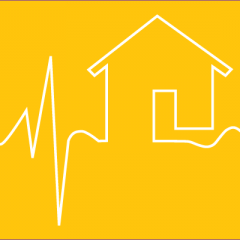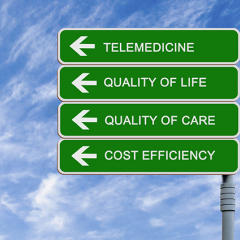How Virtual Care Uptake Can Support Seniors Aging in Place
mHealthIntelligence Due to advances in nearly every aspect of human existence, including healthcare, human beings are living longer lives. As the population ages, and remains active for longer, their care must also evolve to enable seniors to age in place and continue the activities that mean the most to them. At a virtual session during Telehealth Awareness Week, hosted by the American Telemedicine...
More Features
Ensuring Care Continuity Through an EHR-Integrated Telehealth Platform
After investing heavily in virtual care over the course of the COVID-19 pandemic, health systems must now determine how best to integrate telehealth with existing digital tools to create a seamless care journey for patients. In the rush to...
How a New Clinical Innovation Fellowship Will Support RPM, Referrals Management
The digital transformation of healthcare is underway, with the COVID-19 pandemic driving the use of health IT to new heights. But, as healthcare organizations determine how best to incorporate digitally enabled care into their standard...
Expanding Telehealth Key to Care Access, But Tech Infrastructure Needs Upgrade
While policymakers appear keen to extend telehealth flexibilities and ensure expanded access to virtual care, US Sen. John Thune (R-S.D.) believes widespread technology infrastructure issues may hold up their efforts. Thune, who serves as a...
Amazon Poised to Disrupt Virtual Care For a Niche Few
Amazon set the healthcare world abuzz last month when it announced its plan to purchase virtual and in-person primary care organization One Medical for nearly $4 billion. The latest in a string of healthcare moves made by Amazon this year,...
Exploring Clinical Care Use Cases, Digital Health Literacy Gaps in RPM
The virtual care revolution has brought exciting new prospects for remote patient monitoring (RPM). With rapid advancements in technology and growth in patient demand, healthcare providers are exploring new and improved ways to implement...
How Best Buy Plans to Facilitate Provider-Patient Connections to Further RPM
Over the past decade, several high-profile technology and retail companies have made inroads into the healthcare industry. Among these new entrants is a nearly 60-year-old retailer: Best Buy. Though Best Buy remains a prominent consumer...
Using Telehealth to Expand Patient Access to Breastfeeding Support
Breastfeeding provides several benefits for babies and mothers but navigating the process can prove challenging, particularly amid the ups and downs of the newborn phase. Like other aspects of maternal and infant care, virtual care programs...
How Telehealth Can Help Bridge Pediatric Mental Healthcare Gaps
The burgeoning mental health epidemic in America is widespread across age groups, but the youth have faced a particularly challenging time amid the COVID-19 pandemic. As the youth mental health crisis reaches new heights, providers are...
Enhancing Care for Kids with Genetic Conditions Through Telehealth
The uses of telehealth in pediatrics are varied, enabling expanded care for various acute and chronic conditions, like type 1 diabetes and behavioral health. One of the significant use cases of the care modality is diagnosing and caring for...
How FQHCs Are Combating the Digital Divide in Telehealth, Remote Monitoring
Though telehealth remains popular among providers and patients alike, not all populations benefit from the care modality equally. Organizations that provide care to these underserved communities are focusing on mitigating telehealth access...
4 Chronic Care Use Cases for Remote Patient Monitoring
Amid the rapid expansion of virtual care, remote patient monitoring (RPM) has emerged as a reliable tool for treating both acute and chronic conditions. RPM involves leveraging connected digital tools to record personal health data in one...
What Are Digital Therapeutics and Their Use Cases?
The digital transformation of healthcare is underway, bringing with it large-scale changes in various aspects of the healthcare journey, from scheduling visits to care delivery to bill payments. As healthcare processes become increasingly...
HHS, Providers View Audio-Only Telehealth as Key Health Equity Strategy
As telehealth became a must-have in the age of COVID-19, the federal government responded by enacting regulatory flexibilities, providing funding for virtual care efforts, and supporting workforce education and technology implementation at...
Leveraging Telehospitalists in the Age of COVID-19
Telehealth offers a wide array of benefits, including the ability to care for patients outside the hospital and supplement inpatient care. But even within the four walls of a healthcare facility, telehealth can help extend the reach of...
Key Features of mHealth Apps & Trends in Use
mHealth applications have become ubiquitous in the healthcare industry, spanning a wide array of disease states and use cases. There are more than 350,000 health-related apps available on top app stores worldwide, with more than 90,000 new...
Establishing Strong Provider-Patient Relationships Through a Screen
Telehealth offers a myriad of benefits to patients and providers alike but establishing strong relationships through a screen may prove to be a challenge as virtual care use grows. A survey released earlier this year shows that 51 percent...
Understanding Key Telehealth Disparities & Patient-Facing Barriers
Telehealth is here to stay — this oft-repeated phrase now sounds trite, but as the COVID-19 pandemic wears on, it is more accurate than ever. As 2022 dawned, there was an increase in telehealth utilization in every US census region,...
How Telehealth Helped Keep ACOs Afloat During the Pandemic
Telehealth has become a critical part of the care delivery mechanism at organizations across the country, including accountable care organizations (ACOs), which share savings accrued from coordinating care for patients. Like most healthcare...
How Mayo, Geisinger, IU Health Train Their At-Home Care Providers
At-home care programs have proliferated across the country in recent years, primarily driven by the regulatory flexibilities and the in-person care constraints that resulted from the COVID-19 pandemic. Deploying these programs require...


















